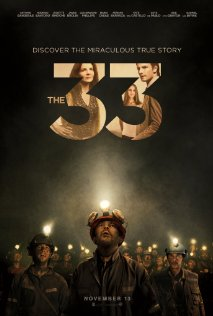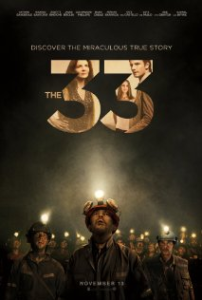
Verdict: Marked by wonderful acting performances, “The 33” is a strong film that successfully mixes tension, emotion and hope at most times.
——————————
There’s a key detail that sets “The 33” apart from the rest in the disaster genre: it’s based on a true story. It is based on the collapse of a gold and copper mine in Chile in 2010, which trapped 33 men for 69 days. Truth is important here, but it is not used just as an excuse for a poor story. On the contrary, “The 33” stands on its own as a film. And it’s a great one.
The quality of this movie begins with the acting. Antonio Banderas plays Mário Sepúlveda in a remarkable leading role. Banderas knows how to be simple and never dictates the tone of the story. He matches it. He shares the screen with his 32 colleagues. His acting goes on a crescendo until the moment he sees light for the first time in two months. It’s emotional and rings true.
Juliette Binoche accomplishes something similar as the sister of a miner. She is so simple and well within her character that it takes some time to recognize her. Her acting speaks much louder than her star. Her chemistry with Rodrigo Santoro, who plays the figure of Chilean Minister of Mines, is a joy to watch. In one scene, he, on the top of the mine, and she, beyond the fence, communicate without a single word. Their faces explain it all: the rescue wasn’t successful yet.
The screenwriters and the director Patricia Riggen do a great job in presenting us to the mine. By focusing on a first time miner, we can experience the same fear he feels when the truck carrying the 33 men enters the mine and the sunlight becomes distant until it disappears.
Riggen’s use of a black screen when the mine falls is also extremely effective. We are about 10 seconds in the dark without sound and it feels like an eternity. It’s the moment when the film best captures the sensation of being buried alive. There are places in the film where I felt those moments or other editing techniques like this could have been used to heighten tension, since the technique of the film feels very conservative overall. Even when the mine comes down, the shots look too stable where I expected a more nervous, shaky camera.
The shot of the first miner being rescued, on the other hand, is fantastic. We stay with him in that small rescue capsule and suddenly we become attentive to every little detail: we don’t want anything to go wrong now. The scene embodies symbolism, and Riggen does a good job in extracting it.
One issue with the film is that at times it seems to spend too much time above the surface of the Earth. I felt that some of this time could have been used to develop more of the secondary miner’s characters. It also creates a distance between us and the miners. The film could have suffocated us more in the mine and expanded on the drama already there.
“The 33” is a well-done film and a wonderful way to pay homage to the 33 survivors, who were never compensated financially after the event. At times, it plays too safe and distances us from the miners a bit, but it is still a good work of art. It is marked by great acting performances, and one that deserves to be seen.

